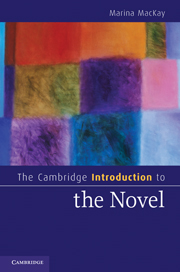Book contents
- Frontmatter
- Contents
- Acknowledgments
- About this book
- Chapter 1 Why the novel matters
- Miguel de Cervantes, Don Quixote (1605, 1615)
- Chapter 2 Origins of the novel
- Laurence Sterne, The Life and Opinions of Tristram Shandy, Gentleman (1759–67)
- Chapter 3 Narrating the novel
- James Hogg, The Private Memoirs and Confessions of a Justified Sinner (1824)
- Chapter 4 Character and the novel
- Nathaniel Hawthorne, The Scarlet Letter (1850)
- Chapter 5 Plotting the novel
- Gustave Flaubert, Madame Bovary (1857)
- Chapter 6 Setting the novel
- Charles Dickens, Bleak House (1853)
- Chapter 7 Time and history
- Virginia Woolf, To the Lighthouse (1927)
- Chapter 8 Genre and subgenre
- Graham Greene, The Ministry of Fear (1943)
- Chapter 9 Novel and anti-novel
- Thomas Pynchon, The Crying of Lot 49 (1966)
- Chapter 10 Novel, nation, community
- Salman Rushdie, Midnight's Children (1981)
- Chapter 11 Concluding
- Notes
- Glossary
- Further reading
- Index
- Cambridge Cultural Social Studies
Chapter 6 - Setting the novel
Published online by Cambridge University Press: 05 June 2012
- Frontmatter
- Contents
- Acknowledgments
- About this book
- Chapter 1 Why the novel matters
- Miguel de Cervantes, Don Quixote (1605, 1615)
- Chapter 2 Origins of the novel
- Laurence Sterne, The Life and Opinions of Tristram Shandy, Gentleman (1759–67)
- Chapter 3 Narrating the novel
- James Hogg, The Private Memoirs and Confessions of a Justified Sinner (1824)
- Chapter 4 Character and the novel
- Nathaniel Hawthorne, The Scarlet Letter (1850)
- Chapter 5 Plotting the novel
- Gustave Flaubert, Madame Bovary (1857)
- Chapter 6 Setting the novel
- Charles Dickens, Bleak House (1853)
- Chapter 7 Time and history
- Virginia Woolf, To the Lighthouse (1927)
- Chapter 8 Genre and subgenre
- Graham Greene, The Ministry of Fear (1943)
- Chapter 9 Novel and anti-novel
- Thomas Pynchon, The Crying of Lot 49 (1966)
- Chapter 10 Novel, nation, community
- Salman Rushdie, Midnight's Children (1981)
- Chapter 11 Concluding
- Notes
- Glossary
- Further reading
- Index
- Cambridge Cultural Social Studies
Summary
Space is not the “outside” of narrative, then, but an internal force, that shapes it from within. Or in other words: in modern European novels, what happens depends a lot on where it happens.
Franco Moretti, Atlas of the European Novel (1998)It does not seem to me to be enough to say of any description that it is the exact truth.
Charles DickensNathaniel Hawthorne begins his preface to The House of the Seven Gables (1851) by distinguishing between the novel and the romance: when an author calls his book a romance, as Hawthorne has, he “wishes to claim a certain latitude, both as to its fashion and material, which he would not have felt himself entitled to assume, had he professed to be writing a Novel.” He wants us to treat as pure invention his cursed New England house as well as the old Puritan Pyncheons who guiltily live there: “the Author … trusts not to be considered as unpardonably offending, by laying out a street that infringes upon nobody's private rights, and appropriating a lot of land which had no visible owner, and building a house out of materials long in use for constructing castles in the air.” What I want to suggest in this chapter, though, is that novelistic setting always collapses the boundaries between the realistic and romantic: to write a place is to imagine a place, to call a new place into being around even an old signpost.
- Type
- Chapter
- Information
- The Cambridge Introduction to the Novel , pp. 99 - 114Publisher: Cambridge University PressPrint publication year: 2010

